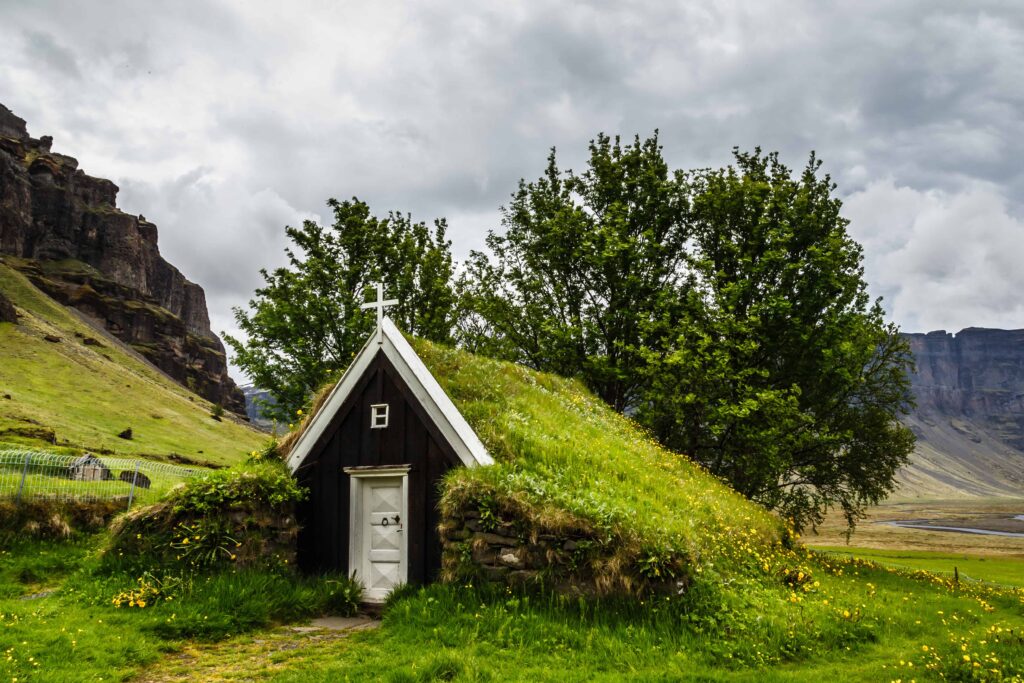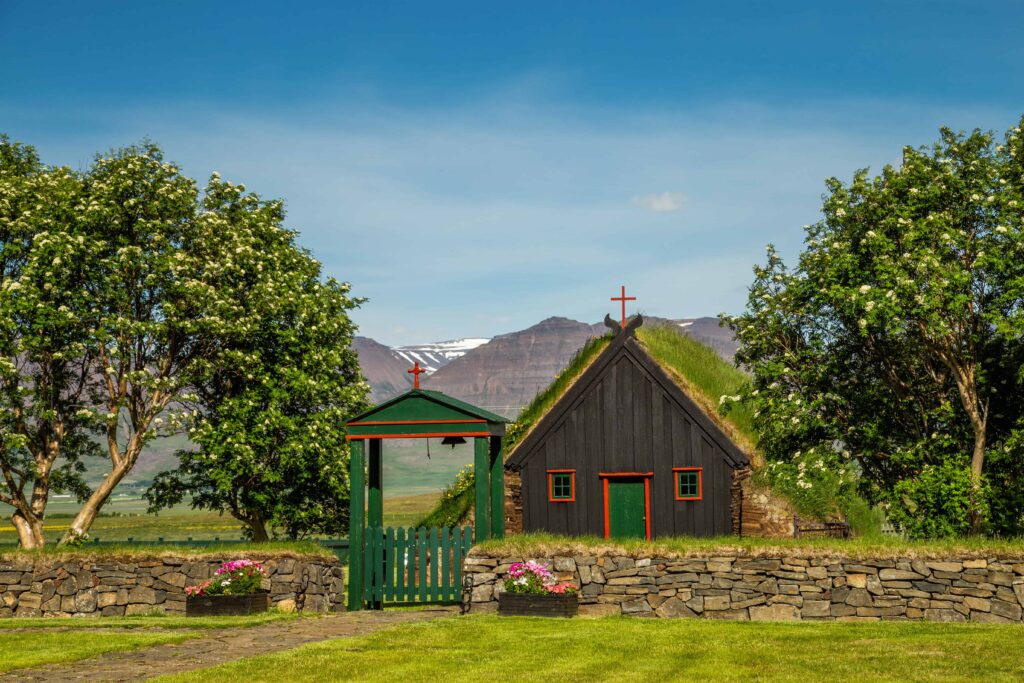Iceland is predominantly associated with the “beauty of nature” because of the amazing landscapes and natural sites that the country flaunts. While this is absolutely true that Iceland is a lot about nature and its architectural miracles but it does not mean that the land of ice and fire is limited to that only. While the beautiful snow-covered glaciers housing raging volcanoes boasts the beauty of nature on one side, the gorgeous contemporary and vintage buildings in the town and village settlements hold the fort from the other side. Iceland is the perfect blend of natural and man-made wonders which seemingly complement each other in a subtle yet powerful way. Some of these man-made wonders include the numerous churches, concert halls, factories turned pubs, and many government buildings.

Churches of Iceland
As far as churches are concerned, Iceland has more than enough of these. For a country of only 364,000 people, there are about 350 churches in Iceland. One would think that Iceland is filled with religious people to the brim considering the sheer number of churches constructed in a country with so less population but that would not be true. Iceland has been recorded as one of the most atheist countries in the world with housing the 6th spot on the list even though 85% of the population is Lutheran Christian by birth.
One of the reasons that there are so many churches in the country is because many people leave their land and property upon death to the churches and authorities that manage them which ultimately results in the construction of new churches.
But recent times have seen a great decline in the attenders of churches. Events like confirmation, baptism, Christmas, wedding, or funerals. The decline happened after the 1970s.
Religion in Iceland
Most people do not believe in the theory that god is the one who created the world and all living things and many people do not follow the Christian idea of sin either. Iceland was voted to be the most godless country in the world in the year 2015. And yet you won’t be able to travel for a few hours without spotting at least one church in literally any settlement across the country.
Every child in Iceland is Baptised and registered as Christians in any of the Lutheran churches of the country at birth. The tradition of confirmation is followed when the child is 14 years old. Even though the majority of the population is Christian, some people insisted on keeping their pagan faith, stories, and practices but that was kept a secret since the compromise between the Christian chieftains and the heathens of Iceland required the citizens to adopt Christianity by law.
Turf Churches – What Is So Special?
The design of Icelandic turf churches took an inspiration from the infamous turf houses of the country. The foundation of the building is laid using huge stones. Wood is then used to erect a structure on the foundation that holds the weight of the roof. The roof of the building is then made using turf which is fitted around the wooden frame on the sides. The only wooden part initially visible is the front part where the door is and the windows if there are any.
This particular practice and style of the building were first developed in North America in the stone age when men people made shelters using wood and turf to protect their livestock from harsh weather.
In literal terms, turf is the combination of grass and the surface layer of the earth that is held on to by the roots of the grass. The buildings that we see today in the form of churches are the modern adaption of this century-old technique of building shelters. Driftwood was the first choice of wood for these constructions. Timber was also imported from time to time from Norway but it proved to be very costly. This is when the idea of using turf came into mind. An alternative to timber, turf proved even sturdier in face of storms and also kept the cold out. This is why turf buildings and churches became an important part of the ancient Icelandic culture and civilization.
The Famous Turf Churches of Iceland
There are a total of six turf churches in Iceland which were made in different periods. Each one of them has its own specialty. Most of these churches are located in the northern part of the country. Let’s have a look:
Grafarkirkja

Grafarkirkja is the oldest standing turf church in Iceland and is located near Hofsós in Skagarfjörður. While the oldest parts of the church standing today date back to only the 17th century, there are many accounts of its existence in Sturlunga Saga. The oldest account dates back to the 12th century when it was a common practice for Icelanders to live in turf buildings. A weather wane is attached to the church with the number 167 showcased on it. The last number or letter from the weather is not there as it may have broken down over time.
What makes Grafarkirkja different from any other turf churches in Iceland is the circular turf wall that surrounds it like a fence. The more recent original churches do not have this kind of construction around them as it is a sign of Grafarkirkja being from ancient times.
Grafarkirkja turf church was demolished by a Danish king in 1765 and remained that way until 1960 when it was acquired and protected by the National Museum which also restored the building to its original form using some new parts. Now the church is closed for visitors in order to preserve it but you can still visit the surrounding area and see the beautiful little building from outside.
Nupsstadarkirkja

The smallest of the turf churches standing today, Nupsstadarkirkja is a turf church located a little bit west of Vatnajökull very close to the famous mountain Lómagnúpur in the settlement known as Núpsstaðir. This particular church has been in existence since 1340. The record shows the existence of a church if not this particular one since the year 1340. Nupsstadarkirkja was adopted by the National Museum of Art of Iceland in the year 1930 and was repaired and reconstructed. The roof and cladding had to be replaced completely but the original foundation of the church was remained to be untouched. The mild restoration work was done between 1958 to 1960 but the replacement of cladding and roof took place in 1970. The church has been standing tall ever since with a beautiful covering of turf.
What makes this little church so special is the exquisite design of the interiors. The alter of the church is also something that was not changed or repaired and currently stands a record of being a-200-year old alter. The walls of the church are decorated with stone and lava murals. The church may be small but it is every bit beautiful as you would except an ancient Icelandic church to be.
Saurbæjarkirkja

Iceland’s longest fjords, Eyjafjörður fjords, houses the biggest turf church Saurbæjarkirkja. This church was made by then Reverend Einar Thorlacius and a popular carpenter Ólafur Briem in the year 1858. This turf church has enough space to fit about 60 people. It looks as if the church is made of wood, stones, and turf like the traditional churches but the scenery inside the church is completely different. As you enter the church, you will find yourself standing inside a timber wood wonderland. Very few of these timber wood churches remain now but the ones that are here with us are very well preserved.
There is a beautiful chapel inside with rows of benches for the worshippers. Just like others of its kind, Saurbæjarkirkja also remains close most of the times but you can easily acquire the key from the framers that live nearby. The contact information is generally displayed outside the church. It is said that there used to be a convent where this church is standing around 1200 but there are limited to none official records to prove the same. There are several things on display in Saurbæjarkirkja which makes it well worth your time. It is only 30 kilometers away from Akureyri and about 409 kilometers away from the capital city, Reykjavik.
Árbæjarkirkja

This particular church does not exist in its original form anymore as it was removed when a new church was built in its place. Árbæjarkirkja was located in Silfrastaðir in north Iceland and was built in 1842. It was torn down shortly after its construction in 1896 – only 54 years later. However, a new church-cum-museum was created in the capital city of Reykjavík which is a spitting image of the original one. This particular church is popularly known by the name Árbæjarsafn Folk Museum.
The timber wood from the original church was first reused for the construction of a sitting room or baðstofa outside the old church on the farm. Later when this sitting area got torn down, the wood was again used to reconstruct Árbæjarkirkja from scratch. It was made sure that every single detail of the church is just like the original one. Árbæjarkirkja is the only turf church that the capital city has so it is well cherished and loved. The church was made a part of the Árbæjarsafn Folk Museum in the year 1961 after its construction in 1956. The alter in the church is the original one from the previous one. You can visit this church on a guided tour organized by several tour agencies in Iceland.
Vidimyrarkirkja

A property of the National Museum of Art since 1936, Vidimyrarkirkja is believed to be the most beautiful turf church among the once standing erect today. the third president of Iceland, Kristján Eldjárn, described this particular church as the most beautiful and clear-cut relic of Icelandic ancient architecture. Kristján Eldjárn was the director of the National Museum of Art prior to becoming the president of the country. Despite being one of the most beautiful examples of the old architecture of the land of ice and fire, this church was under the danger of being torn away and replaced by a modern-day concrete church. It was another director of the National Museum of Art of Iceland, Matthías Þórðarson, who saved it and preserved its beauty.
Vidimyrarkirkja was built using turf from Víðimýri and the driftwood was scored from the nearby Skagi peninsula. The construction was initiated and completed in the year 1834. There is also a lychgate in the front of the church which was built in 1836 but the bell that is hung from it dates back to the year 1630. Beautiful bright colors like orange and green are used to stain the wood along with the common black color. The turf of the church is regularly renewed so that the dried-up grass is replaced with more lush green grass.
Hofskirkja

While the site for this turf church has been a place of worship for over 700 years, the actual building is the newest one that we have in the line of turf churches in Iceland. Hofskirkja is located in Öræfi, to the east side of Skaftafell. The church was constructed by Paul Pálsson in the year 1883-1885 and the restoration was done in the year 1954 when it was taken in by the National Museum of Art of Iceland. The earliest mention of a church on these grounds dates back to the year 1343 in an ancient medieval document. This particular church has walls that are constructed using rocks and the roof is made with turf. The church is now closed to the public for preservation purposes.





















































